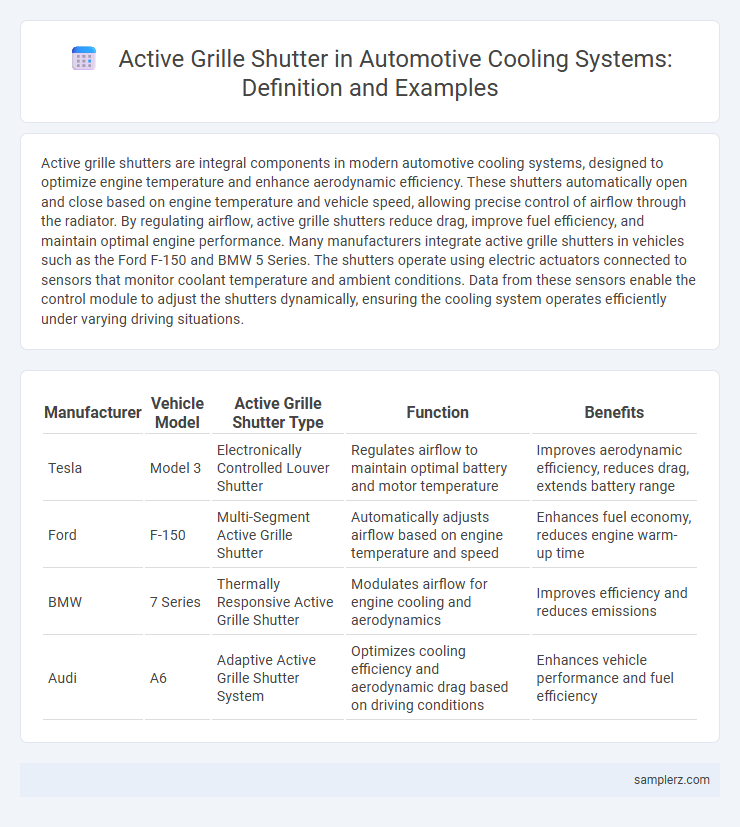Active grille shutters are integral components in modern automotive cooling systems, designed to optimize engine temperature and enhance aerodynamic efficiency. These shutters automatically open and close based on engine temperature and vehicle speed, allowing precise control of airflow through the radiator. By regulating airflow, active grille shutters reduce drag, improve fuel efficiency, and maintain optimal engine performance. Many manufacturers integrate active grille shutters in vehicles such as the Ford F-150 and BMW 5 Series. The shutters operate using electric actuators connected to sensors that monitor coolant temperature and ambient conditions. Data from these sensors enable the control module to adjust the shutters dynamically, ensuring the cooling system operates efficiently under varying driving situations.
Table of Comparison
| Manufacturer | Vehicle Model | Active Grille Shutter Type | Function | Benefits |
|---|---|---|---|---|
| Tesla | Model 3 | Electronically Controlled Louver Shutter | Regulates airflow to maintain optimal battery and motor temperature | Improves aerodynamic efficiency, reduces drag, extends battery range |
| Ford | F-150 | Multi-Segment Active Grille Shutter | Automatically adjusts airflow based on engine temperature and speed | Enhances fuel economy, reduces engine warm-up time |
| BMW | 7 Series | Thermally Responsive Active Grille Shutter | Modulates airflow for engine cooling and aerodynamics | Improves efficiency and reduces emissions |
| Audi | A6 | Adaptive Active Grille Shutter System | Optimizes cooling efficiency and aerodynamic drag based on driving conditions | Enhances vehicle performance and fuel efficiency |
Introduction to Active Grille Shutters in Automotive Cooling
Active grille shutters enhance automotive cooling efficiency by dynamically adjusting airflow through the radiator based on engine temperature and vehicle speed. These electronically controlled panels reduce aerodynamic drag by closing at high speeds while opening to allow maximum airflow during engine cooling demands. This technology optimizes fuel economy and maintains optimal engine temperature, contributing to overall vehicle performance and emissions reduction.
Key Benefits of Active Grille Shutters for Vehicle Efficiency
Active grille shutters enhance vehicle efficiency by dynamically regulating airflow through the radiator, reducing aerodynamic drag at higher speeds. By closing shutters when engine cooling demand is low, fuel consumption decreases, leading to improved miles per gallon (MPG) ratings. This technology also contributes to faster engine warm-up, reducing emissions and optimizing overall thermal management.
How Active Grille Shutters Work in Cooling Systems
Active grille shutters regulate airflow through the vehicle's radiator by opening and closing automatically based on engine temperature and vehicle speed. When the engine temperature is low, shutters close to reduce aerodynamic drag and improve fuel efficiency, while opening at higher temperatures to allow maximum air to cool the radiator. This dynamic adjustment optimizes the cooling system's performance and enhances overall thermal management in modern automotive engines.
Example: Ford’s Active Grille Shutter Technology
Ford's Active Grille Shutter Technology dynamically adjusts airflow to optimize engine cooling and improve fuel efficiency by reducing aerodynamic drag. The system uses electronically controlled shutters that open during high engine temperatures to increase cooling or close at optimal conditions to enhance vehicle aerodynamics. This technology contributes to lower emissions and improved powertrain performance in Ford's modern vehicles.
Example: GM’s Active Aero Shutter Systems
GM's Active Aero Shutter Systems integrate active grille shutters to optimize the engine cooling process by dynamically controlling airflow based on vehicle speed and engine temperature. These shutters close at higher speeds to reduce aerodynamic drag, enhancing fuel efficiency, and open when additional cooling is necessary to maintain optimal engine operation. This system improves thermal management while contributing to overall vehicle performance and emissions reduction.
Example: BMW’s Active Air Stream Kidney Grille
BMW's Active Air Stream Kidney Grille enhances engine cooling efficiency by dynamically regulating airflow through the grille based on temperature and driving conditions. This active grille shutter system reduces aerodynamic drag, improving fuel efficiency while ensuring optimal engine temperature management. Integrated sensors monitor heat levels, enabling precise control of the shutters to balance cooling performance and aerodynamic benefits.
Example: Volkswagen’s Adaptive Cooling Shutters
Volkswagen's Adaptive Cooling Shutters enhance engine efficiency by dynamically regulating airflow through the grille, reducing drag and improving fuel economy. These active grille shutters respond to real-time temperature and speed data, opening to increase cooling when the engine is hot and closing at high speeds to optimize aerodynamics. This innovation exemplifies advanced thermal management in automotive cooling systems, contributing to lower emissions and enhanced vehicle performance.
Implementation Challenges of Active Grille Shutters
Active grille shutters in automotive cooling systems face implementation challenges such as precise control algorithms to optimize airflow while maintaining engine temperature. Integration complexity arises from the need to coordinate with engine management and aerodynamic systems, ensuring seamless operation under varying speed and environmental conditions. Material durability and actuator reliability are critical to withstand extreme temperatures and frequent cycling during vehicle operation.
Impact of Active Grille Shutters on Fuel Economy
Active grille shutters optimize engine cooling by regulating airflow based on real-time temperature and speed data, reducing aerodynamic drag on vehicles like the Ford F-150. This technology can improve fuel economy by up to 5% in highway driving conditions due to decreased air resistance. Enhanced thermal management from active grille shutters also contributes to reduced engine warm-up times, further boosting overall energy efficiency.
Future Trends in Automotive Active Grille Shutter Technology
Future trends in automotive active grille shutter technology emphasize enhanced aerodynamic efficiency and thermal management through smarter, adaptive control systems integrating AI and sensor fusion. Advances in materials and actuator designs aim to reduce response time and energy consumption, contributing to improved fuel economy and reduced emissions. Integration with electric and hybrid powertrains enables dynamic airflow regulation, optimizing battery cooling and extending component lifespan.

example of active grille shutter in cooling system Infographic
 samplerz.com
samplerz.com